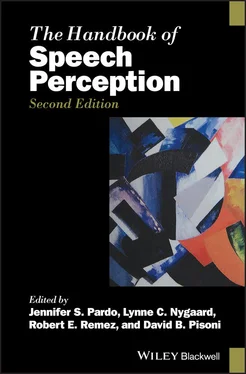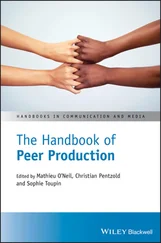While historically the relationship between speech perception and production has been implicated as explanations of language change, patterns of language disorder, and the developmental time course of speech acquisition, there has been little comprehensive theorizing about how speech input and output interact (Levelt, 2013). Recently, Kittredge and Dell (2016) outlined three stark hypotheses about the relationship between speech perception and production. In their view, the representations for perception and production could be completely separate, absolutely inseparable, or separable under some if not many conditions.
A number of different types of experimental evidence might distinguish these possibilities, including (1) data that examine whether learning/adaptation changes in perception influence production and vice versa; (2) correlational data showing individual differences in the processing of speech perception and production (e.g. perceptual precision and production variability); and (3) data showing interference between the two processes of perception and production.
Learning/adaptation changes
In speech perception, selective adaptation for both consonants and vowels results in changes to category boundaries after exposure to a repetitive adapting stimulus. Cooper (1974; Cooper & Lauritsen, 1974) reported production changes in produced VOT following repeated presentation of a voiceless adapting stimulus. In a manner similar to the effects of selective adaptation on perceptual category boundaries, talkers produced shorter VOTs after adaptation. The effect was attributed to a perceptuomotor mechanism that mediates both the perception and the production of speech. More recently, Shiller et al. (2009) found that, when subjects produced fricatives with frequency‐altered feedback, they produced fricatives that compensated for the perturbation. Most interestingly, the subjects shifted their perceptual boundary for /s/–/sh/ identification following this production perturbation. However, as Perkell (2012) cautions, the segment durations of the fricatives were far beyond the natural range, raising the possibility that the effect was acoustic rather than phonetic. Lametti et al. (2014) showed the opposite direction of influence. A perceptual training task designed to alter perceptual boundaries between vowels preceded a production task. No shift was observed in baseline vowel formant values but a difference was observed in the magnitude of compensation to F1 perturbations. Oddly, this difference was observed in a follow‐up days later. The persistence is surprising for a number of reasons. First, the speech adaptation effects produced by formant shifts themselves drift away relatively quickly within an experimental session following return to normal feedback. Second, the perceptual training didn’t influence baseline vowel production immediately after training nor days later. The influence of perceptual change on production is shown only in the magnitude of compensation (i.e. in the behavior of the auditory feedback processing system). Finally, the length of effect is noteworthy. While it is not unheard of for perceptual effects to persist across many days, it is not common; the McCollough effect in vision has been shown to last for months after a 15‐minute training period (Jones & Holding, 1975). However, the reinforcement learning paradigm used by Lametti et al. (2014) is considerably different from the adaptation approach used in other studies and suggests a more selective influence on the perception–production linkage.
The published data suggest modest effects from speech‐perception training on speech production and vice versa. As Kittredge and Dell (2016) suggest, the pathway for exchange between the input and output systems may be restricted to a small set of special conditions. Kittredge and Dell suggest that one possibility is that perceptual behavior that involves prediction invokes the motor system and this directly influences production.
A separate line of research has suggested this influence may exist but has shown similar, small effect sizes in experiments. In the study of face‐to‐face conversations, considerable theoretical proposals support the idea that interlocutors align their language at many levels (Garrod & Pickering, 2004). At the phonetic level, the findings have been weak but consistent. Few acoustic findings support alignment but small perceptual effects have been frequently reported (Pardo et al., 2012; Kim, Horton, & Bradlow, 2011. The surprising aspect of these findings is the small effect size. Given the proposed importance of alignment in communication (and the proposed linkage between perception and production; Pickering & Garrod, 2013), the small influence is problematic.
The data linking perception and production within individuals are also surprisingly sparse. Most of the data show that talkers’ perception and production categories are somewhat similar. For example, Newman (2003) found small correlations between the VOT prototypes of listeners and their production VOT values (accounting for approximately 27 percent of the variance). However, Frieda et al. (2000) did not find such a correlation for the perceptual prototype for the vowel /i/ and production values. Fox (1982) showed that the factor analysis dimensions derived from listeners’ judgments of similarity between vowels could be predicted by the acoustics of vowels produced by the participants, but only by the corner vowels /i, u, A/. Bell‐Berti et al. (1979) categorized the manner in which participants produced the tense/lax distinction in front vowels based on their examination of electromyographic recordings. They later found that those participants who used a tongue‐height production strategy showed larger boundary shifts in an anchoring condition in a vowel‐perception test than those who used a muscle tension implementation of tense/lax. Perkell et al. (2004) also grouped participants on the basis of measurements of production data, and found that these groups performed differently in perception tests. The more distinct the production contrasts between two vowels that talkers produced the more likely those subjects were able to distinguish tokens in a continuum of those vowels.
The most recent evidence in support of this correlational relation between perception and production abilities comes from Franken et al. (2017). In this study, production variability for vowel formant values was measured and the ability to discriminate between vowel tokens assessed. These two variables were found to correlate in their data. However, the correlations are modest and smaller than those reported by Perkell et al. (2004). The argument put forward in Franken et al. (2017) is that talkers with better perceptual acuity are less variable in production and that these talkers are more sensitive to feedback discrepancies. Indeed, Villacorta, Perkell, and Guenther (2007) showed a greater response to formant perturbation in subjects who had greater acoustic acuity. However, this finding is inconsistent with MacDonald, Purcell, and Munhall’s (2011) meta‐analysis of the variability of production and compensation magnitude in F1 and F2 for 116 subjects. The lack of relationship between variability and compensation observed by MacDonald et al. is important given the large sample size considered in their analysis.
If the two processes of perception and production of speech share a common representation or resource, there should be evidence that the performance of one process can interfere with or in some cases enhance the performance of the other process. There are tantalizing findings of this kind in the speech perception–production literature. At the adult level, there are a series of imaging studies and transcranial magnetic stimulation (TMS) studies that document possible interference or enhancement effects (see Skipper, Devlin, & Lametti, 2017, for a review; cf. Hickok, 2014, for a critical review of findings that relate to the mirror neuron hypothesis; Hickok, Holt, & Lotto, 2009, for criticism of motor influences on perception). Janet Werker and colleagues have reported a series of intriguing studies on early speech development that relate production to perceptual abilities (e.g. Bruderer et al., 2015). As has previously been shown by Werker and others, young infants are capable of perceptually making nonnative phonetic category distinctions. Using unique methods, they have shown that the ability to make these perceptual distinctions is reduced when the effector responsible for producing the distinction (i.e. the tongue in Bruderer et al.’s 2015 study) is interfered with by a custom‐designed soother. When a different soother, which did not interfere with the tongue’s movement, was used during the perceptual phase of the study, no perceptual interference was observed. Infants could perceive the lingual nonnative contrast if the tongue was not constrained by a soother. These six‐month‐old infants had not learned their perceptual or productive native sound inventory at the point of testing. Yet, there appears to be a sensorimotor linkage between phonetic perception and the articulatory system. In a follow‐up study, Choi, Bruderer, and Werker (2019) showed that the perception of nonnative contrasts as shown by Bruderer et al., and native contrasts (e.g. a /b/–/d/ distinction) can be interfered with by soothers that block the movement of key articulators in the production of the distinction (e.g. tongue tip, lips). These studies suggest a direct linkage between the speech motor and perception systems (Bruderer et al., 2015). Further, the results suggest an auditory–effector mapping that is available very early in development.
Читать дальше








![О Генри - Справочник Гименея [The Handbook of Hymen]](/books/407356/o-genri-spravochnik-gimeneya-the-handbook-of-hymen-thumb.webp)



